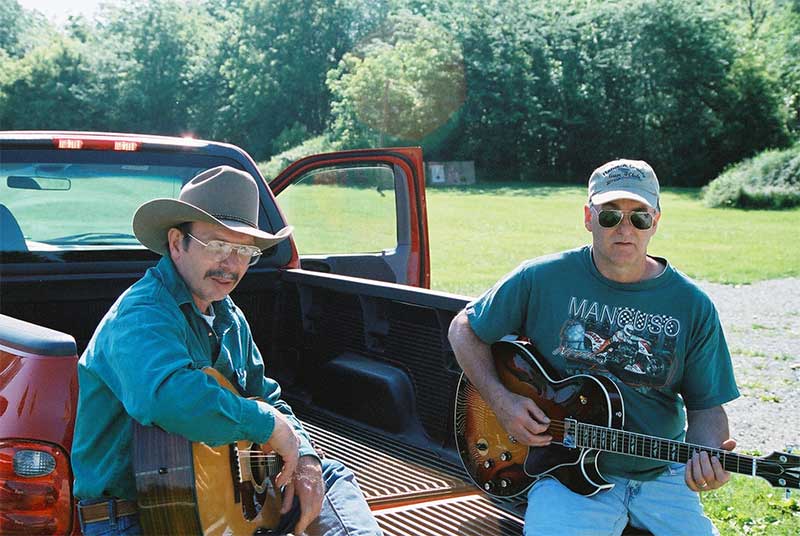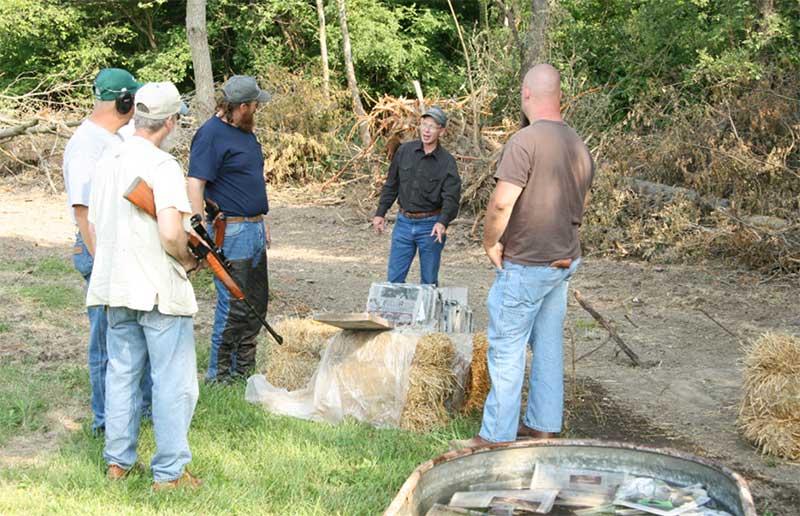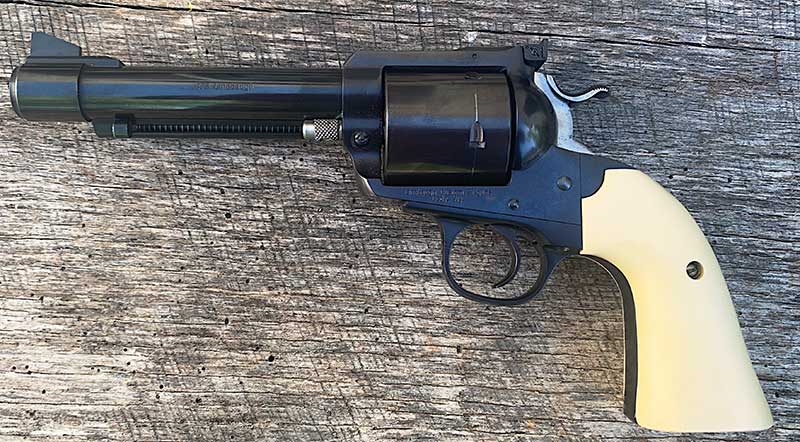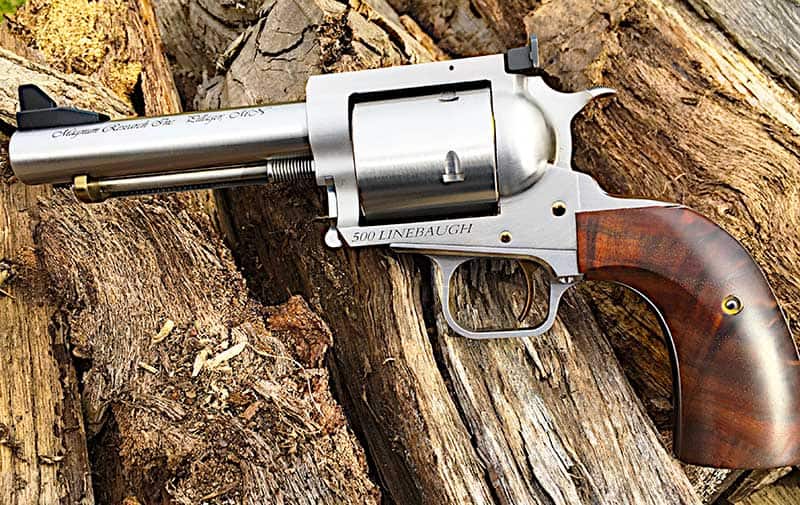101
Mourning The Loss Of
Big Bore Mentor John Linebaugh
This past Sunday, noted big bore enthusiast and gunsmith extraordinaire John Linebaugh passed away while doing what he loved most, working one of his machines and building big bore single action revolvers.
Linebaugh was a true pioneer in the big bore game by living, breathing and believing in Sir Samuel Baker’s theory, “Bullet diameter and weight are constant. Velocity is the only diminishing characteristic.” This statement is the heart and soul of big bore enthusiasts. Large-diameter, heavy bullets, at moderate velocity, drive deeper and straighter, creating large wound channels. Linebaugh believed in chambering a gun with cartridges having these characteristics in compact, packable handguns. And that is exactly what he strived for and accomplished with his guns.
Naturally, we’re talking about the cartridges he designed, bearing his name — the .500 and .475 Linebaugh cartridges. But he also had a fondness for .45 Colts and .38-40s.
Linebaugh was a student of Elmer Keith, picking up where the master left off, with his cartridge and gun designs, and also that of famed hunter John “Pondoro” Taylor, also a fan of large, heavy bullets, at moderate velocity, for large, dangerous game. He has been described by many as being humble, always generous with his knowledge, and sharing how he built his revolvers while giving advice and encouragement freely. He relished these exchanges at the many seminars he held.
.45 Colt
Linebaugh’s early experiments were done while turbo-charging the humble .45 Colt. As this grand cartridge is my all-time favorite, I quickly became a fan of his. In those early days, he claimed velocities from his custom revolvers of 260-grain bullets, both cast and jacketed, being driven over 1700 feet per second; 310-grain bullets to 1565 feet per second; 325-grain bullets to 1600 feet per second; and 385-grain bullets to 1300 feet per second. Chronographs validated his claims, and people started taking notice of the Linebaugh name.
Besides the above-listed high-performance loads, my favorite “pet” load comes from Linebaugh too. It’s for large-frame Ruger revolvers only. The load consists of 8.0 grains of Winchester 231 over a 250-260 grain cast bullet for approximately 900 FPS, depending on barrel length. It burns clean, shoots accurately and is pleasant to shoot.
Some Background
John came out with the .500 Linebaugh in 1986. Using cutdown .348 Winchester rifle brass as the parent cartridge, he shortened it to 1.405 inches and used jacketed bullets of .510 inch diameter or cast lead bullets of .512 or .513 inches. Ballistic performance from a packable 5.5-inch revolver shows 435-grain bullets going 1,300 FPS and 525-grain bullets doing 1,100 FPS for plenty of smackdown on large critters.
He told me years ago his .500 does the same as his .475, at half the pressure. I’d wanted a .500 Linebaugh ever since I heard those words.
Brass?
Finding a reliable source of .348 Winchester brass in the late 80s was tough and led to the development of the .475 Linebaugh a couple of years later. The .45-70 is the parent cartridge of the .475 Linebaugh, cut down to 1.4 inches. What developed was a cartridge with essentially the same bullet weights driven at the same velocities as the .500, but with better sectional density, due to the smaller bullet diameter, making them better penetrators.
It was a win-win situation for users of big-bore revolvers. Now, companies such as Starline Brass make both .475 and .500 Linebaugh in factory fresh batches for our convenience. Availability is no longer a problem
The .475 Linebaugh
I only own one original Linebaugh-built gun, but it has quite the track record. It was originally won in a raffle at a Linebaugh seminar by the father of a good friend of mine, Chuck Smith. The gun was later traded to another friend, Glenn Swaggart, who eventually sold it to me several years ago. It is made in classic Linebaugh style — all blued, with a free spinning cylinder, integrally banded front sight base, smooth action and very accurate.
Magnum Research BFR .500 Linebaugh
A few years ago, Magnum Research offered an Elmer Keith commemorative from their custom shop. You know how every now and then you see a gun and you know you just “have to have one?” That was me! I contacted Brett Pikula, who runs the custom shop and ordered one. Before I knew it, it was here, and I was mightily impressed!
The fit and finish is impeccable, the action is smooth, and the trigger crisp and light. It even has a base-pin locking latch like Elmer Keith had on his famous No. 5 revolver, along with a free-spinning cylinder. Here was a 5.1-inch barreled gun chambered for a powerful cartridge capable of launching 450-grain bullets over 1,200 FPS. You can load them hotter, but 1,200 FPS was plenty of fun for me.
Why?
Having a true big-bore handgun is a personal choice. Who wouldn’t want to heave large chunks of lead from a hand cannon in the name of fun? Who doesn’t enjoy watching geysers of dirt and rock erupt from the impact of bullets weighing over 400+ grains of lead from a handgun? Having a finely tuned handgun with big holes in its cylinder and barrel is cool. Loading them in your gun is very satisfying as they “plunk” into the cylinder, ready to be shot.
The Last Word
A man like John Linebaugh only comes along once in our lifetime. A true innovator, mentor, experimenter and friend to many, he will be missed. He leaves behind his vast knowledge through his guns, cartridges, family and friends as his legacy. When one hears his name, you can’t help but think of a fine big bore single action revolver chambered in one of his cartridges bearing his name. So long, John, you will be sorely missed.







